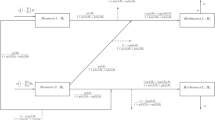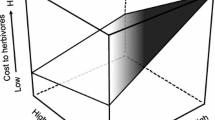Abstract
Stoichiometric analysis recognizes that a herbivore is a mixture of multiple chemical elements, especially C, N, and P, that are fixed in various proportions. In the face of a variable quality food supply, herbivores must regulate ingested nutrients to maintain a homeostatic state. We develop a dynamic mathematical model, based on differential assimilation, that controls the C: N and C: P ratios in a herbivore within given tolerance ranges; the actual mathematical mechanism is to define the absorption coefficients to be dependent on these elemental ratios. The model inputs variable, time-dependent food and grazing rates and calculates the net dynamic consumer production (growth) of C, N, and P. It shows that total growth is equally sensitive to variations in both food quality and in assimilation rates, and it shows quantitatively how C-, N-, or P-limited growth could occur at different periods during the development period. The analysis generalizes earlier work limited to just two elements.
Similar content being viewed by others
References
Anderson, T. R. and D. O. Hessen (1995). Carbon or nitrogen limitation in marine copepods. J. Plankton Res. 14, 1645–1671.
Bloom, A. J., F. S. Chapin III and H. A. Mooney (1985). Resource limitation in plants—an economic analogy. Annu. Rev. Ecol. Systematics 16, 363–392.
Brett, M. (1993). Comment on “Possibility of N or P limitation for planktonic cladocerans: an experimental test” (J. Urabe & J. Watanabe) and “Nutrient element limitation of zooplankton production” (D. O. Hessen). Limnology Oceanography 38, 1333–1337.
Dade, W. B., P. A. Jumars and D. L. Penry (1990). Supply-side optimization: maximizing absorptive rates, in Behavioral Mechanisms of Food Selection, NATO ASI series G 20, R. N. Hughes (Ed.), Berlin: Springer, pp. 531–555.
Daufresne, T. and M. Loreau (2001). Plant-herbivore interactions and ecological stoichiometry: when do herbivores determine plant nutrient limitation? Ecol. Lett. 4, 196–206.
DeAngelis, D. L. (1992). Dynamics of Nutrient Cycling and Food Webs, London: Chapman-Hall.
Frost, P. C. and J. J. Elser (2002). Growth responses of littoral mayflies to the phosphorus content of their food. Ecol. Lett. 5, 232–240.
Gurney, W. C. and R. M. Nisbet (1998). Ecological Dynamics, Oxford: Oxford University Press.
Jumars, P. A. (2000). Animal guts as nonideal chemical reactors: maximizing absorption rates. Amer. Nat. 155, 527–543.
Jumars, P. A. and C. Martínez del Rio (1999). The tau of continuous feeding on simple foods. Physiol. Biochem. Zool. 72, 633–641.
Karasov, W. H. and I. D. Hume (1997). Vertebrate gastrointestinal system, in Handbook of Physiology, Section 13, Comparative Physiology, W. H. Dantzler (Ed.), Oxford: Oxford University Press.
Kooijman, S. A. L. M. (1995). The stoichiometry of animal energetics. J. Theor. Biol. 177, 139–149.
Kooijman, S. A. L. M. (2000). Dynamic Energy Budgets, Cambridge: Cambridge University Press.
Lika, K. and R. M. Nisbet (2000). A dynamic energy budget model based on partitioning of net production. J. Math. Biol. 41, 361–386.
Lotka, A. (1925). Elements of Physical Biology, Baltimore: Williams & Wilkins.
Logan, J. D., A. Joern and W. Wolesensky (2002). Location, time, and temperature dependence of digestion in simple animal tracts. J. Theor. Biol. 216, 5–18.
Logan, J. D., A. Joern and W. Wolesensky (2003a). Chemical reactor model of optimal digestion efficiency with constant foraging costs. Ecol. Modelling 168, 25–38.
Logan, J. D., A. Joern and W. Wolesensky (2003b). Mathematical model of consumer homeostasis control in plant-herbivore dynamics. Math. Comput. Modelling (in press).
Loladze, I., Y. Kuang and J. J. Elser (2000). Stoichiometry in producer-grazer systems: linking energy flow with element cycling. Bull. Math. Biol. 62, 1137–1162.
Loladze, I., Y. Kuang, J. J. Elser and W. F. Fagan (2004). Competition and stoichiometry of two predators on one prey. Theor. Popul. Biol. 65, 1–15.
Martínez del Rio, C. and W. Karasov (1990). Digestion strategies in nectar and fruit-eating birds and the sugar composition of plant rewards. Amer. Nat. 135, 618–637.
Mueller, E. B., R. M. Nisbet, S. A. L. M. Kooijman, J. J. Elser and E. McCauley (2001). Stoichiometric food quality and herbivore dynamics. Ecol. Lett. 4, 519–529.
Raubenheimer, D. and S. J. Simpson (1994). The analysis of energy budgets. Funct. Ecol. 8, 783–791.
Raubenheimer, D. and S. J. Simpson (1997). Integrative models of nutrient balancing: application to insects and vertebrates. Nutr. Res. Rev. 10, 151–171.
Shindler, D. E. and L. A. Eby (1997). Stoichiometry of fishes and their prey: implications of nutrient recycling. Ecology 76, 1816–1831.
Sibly, R. M. (1981). Strategies of digestion and defecation, in Physiological Ecology: An Evolutionary Approach to Resource Use, C. R. Townsend and P. Calow (Eds), Sunderland, MA: Sinauer Associates, pp. 109–139.
Simpson, S. J. and D. Raubenheimer (1993). A multi-level analysis of feeding behaviour: the geometry of nutritional decisions. Phil. Trans. Biol. Sci. 342, 381–402.
Simpson, S. J. and D. Raubenheimer (2000). The hungry locust. Adv. Study Behav. 29, 1–44.
Sterner, R. W. (1997). Modelling interactions of food quality and quantity in homeostatic consumers. Freshwater Biol. 38, 473–481.
Sterner, R. W. and D. O. Hessen (1994). Algal nutrient limitation and the nutrition of aquatic herbivores. Annu. Rev. Ecol. Systematics 25, 1–29.
Sterner, R. W. and J. J. Elser (2002). Ecological Stoichiometry, Princeton: Princeton University Press.
Tang, K. W. and H. G. Dam (1999). Limitation in zooplankton production: beyond stoichiometry. Oikos 84, 537–542.
Thingstad, T. F. (1987). Utilization of N, P, and organic C by heterotrophic bacteria. Mar. Ecol. Prog. Ser. 35, 99–109.
Whelan, C. J. and K. A. Schmidt (2003). Food acquisition, processing and digestion, in Foraging, D. W. Stephens, J. S. Brown and R. Ydenberg (Eds), Chicago: University of Chicago Press, Chapter 6.
White, T. C. R. (1993). The Inadequate Environment: Nitrogen and the Abundance of Animals, Berlin: Springer.
Wolesensky, W. (2002). Mathematical model of digestion modulation in grasshoppers. PhD dissertation, University of Nebraska-Lincoln, Lincoln, NE.
Wolesensky, W., A. Joern and J. D. Logan (2003). A model of digestion modulation in grasshoppers. Ecol. Modelling (in review).
Woods, H. A. and J. G. Kingsolver (1999). Feeding rate and the structure of protein digestion and absorption in Lepidopteran midguts. Arch. Insect Biochem. Physiol. 42, 74–87.
Yang, Y. and A. Joern (1994). Influence of diet quality, developmental stage, and temperature on food residence time in the grasshopper Melanoplus differentialis. Physiol. Zool. 67, 598–616.
Zanotto, F. P., S. M. Gouveia, S. J. Simpson, D. Raubenheimer and P. C. Calder (2000). Nutritional homeostasis in locusts: is there a mechanism for increased energy expenditure during carbohydrate overfeeding? J. Exp. Biol. 2437–2448.
Zanotto, F. P., S. J. Simpson and D. Raubenheimer (1993). The regulation of growth by locusts through post-ingestive compensation for variation in the levels of dietary protein and carbohydrate. Physiol. Entomology 18, 425–434.
Author information
Authors and Affiliations
Corresponding author
Rights and permissions
About this article
Cite this article
Logan, J.D., Joern, A. & Wolesensky, W. Control of CNP homeostasis in herbivore consumers through differential assimilation. Bull. Math. Biol. 66, 707–725 (2004). https://doi.org/10.1016/j.bulm.2003.10.008
Received:
Accepted:
Issue Date:
DOI: https://doi.org/10.1016/j.bulm.2003.10.008




